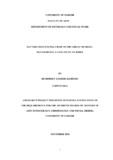| dc.description.abstract | Around the world, violence and crime are increasingly being cited as a problem
towards development, especially in urban locations. Violence and crime in urban
locations do not occur spontaneously, but bound to occur due to social exclusion and
inequality. The persons staying within the informal settlements are more at risk;
especially the poor in the urban areas who are prone to violence and crime. This study
focused on investigating the factors influencing crime in Kibra informal settlement,
Nairobi with the following variables considered: - nature and incidence of crimes in
Kibra informal settlement, type of behaviors perceived as criminal by youth,
determining the characteristics of the slums that reinforce criminal behaviour and
establishing whether there are significant differences regarding crime based on levels
of education, status in employment and gender. In this study, the design used for
research was descriptive. Target population were residents of Kibra who were 18
years old and above. Sampling was done through systematic random sampling in
picking households and getting 120 residents. Purposive sampling was used to select
18 key informants. Both secondary and primary data was used whereby the latter was
obtained from interviewing guide and questionnaires. An SPSS version 22 computer
software was used to analyse quantitative data. Analysis and presentation of
quantitative and statistical data was also achieved by descriptive method. This
approach is important because it allows the researcher to outline the results
statistically through statistical measures of central tendencies, dispersions, frequency
distribution and percentages. Figures and tables were then incorporated to present the
analyzed data. Qualitative data was organized into themes and used to augment
quantitative data. The study established robbery was the common type of crime in
Kibra followed by pick pocketing. However, security improvement has been noted
due to the increased number of security officers and community policing initiative.
Alcoholism, idleness, drug abuse, gambling, being manipulative and anti-social were
some of the behaviours perceived as crime in Kibra Informal Settlement. The study
identified poverty and unemployment as major factors that lead to high crime rate in
the area. The study established that most of the thefts, burglaries, assault cases, drug
trafficking, mugging, murder and pick pocketing were attributed to men living in the
Slum. However, the study established that women handled most of kidnapping cases.
The study recommends beefing up the number of police personnel, vehicle or patrols
cars would assist in containing crime. The study also recommends the government,
non-government organizations and the community to reduce youth crime through
introduction of vocational training, which can help the youths in self-employment
hence limiting unemployment and idleness. Additionally, the government needs to
partner with the youths; through this they might come up with ideas on creating more
job opportunities through self-employment and through this, the youths will be more
engaged hence shun criminal activities. Further, Study recommendations include
government support to youths in attaining more education and this would lead to
reduction of idleness and joblessness. | en_US |



